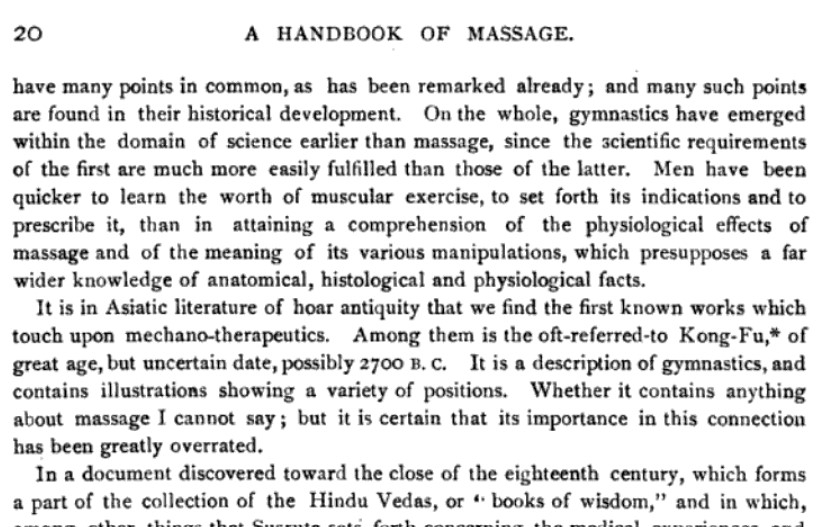ELAP Recommendation: Having completed 1.5 hours of instruction on the evolution of massage and bodywork, the learner is expected to:
Demonstrate knowledge of the terms and concepts related to the evolution of massage and bodywork including historical events, knowledge of the current structure of the massage and bodywork profession including massage as part of health care, relevant organizations, work environments, client types, and their needs and wants, on a written examination.
3000 BC– Chinese: Cong-Fu of the Toa-Tse. Oldest known book written about massage. Translated to French in 1700’s. (Mentioned in Kellogg’s book, The Art of Massage, free on Google books, written in 1895). (Mentioned in Kleen’s book, The Handbook of Massage, 1892)
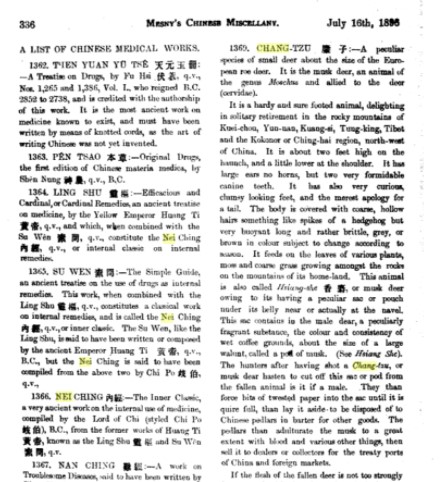
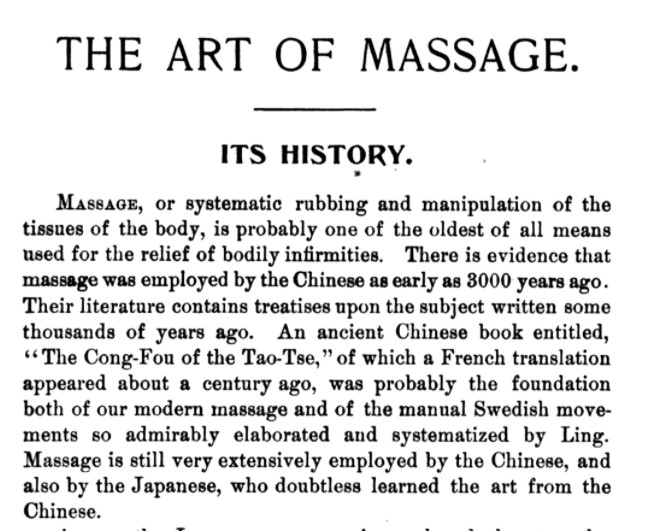
The Cong Fu, according to A MANUAL TREATMENT BY MASSAGE METHODICAL MUSCLE EXERCISE. BY JOSEPH SCHREIBER, M.D., translated by WALTER MENDELSON, M.D. in 1887. (archive.org) is “the oldest book of the Chinese, the Cong-Fou, contains detailed accounts of medical gymnastics, illustrated by drawings which show what correct ideas on mechano-therapy this ancient nation had. The title of the book Cong-Fou indicates its contents: “Cong” meaning an art, “Fou ” a man ; therefore, ” the man who uses an art ” [or perhaps ” the art used upon man ” ?]. “
2500 BC – Egyptians created reflexology.
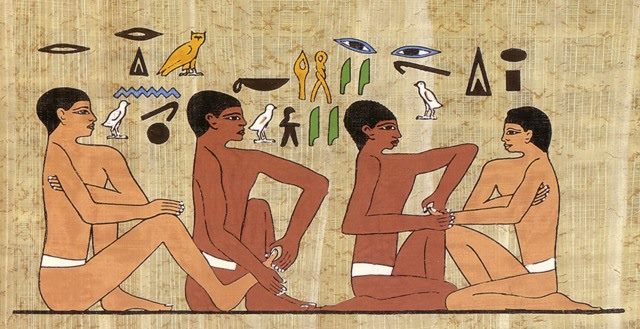
2200 BC- First Writings about Massage (muššu’u and also translated as ‘Rubbing’) is written for the first time, and its use is described in some Sumerian and Akkadian texts found at the beginning of the 21st century in ancient Mesopotamia. The hieroglyphs are said to read “Don’t hurt me”.
1600 BC. Ebers Papyrus contains the statement: “rubbed with vinegar”. This could be part of a ritual or could be a poultice application or it could be massage. (If so, this is often said to be the earliest mention of the word massage… or is the listing at 2200 BC the first?)
1000 BC– Homer wrote about an oily medium used for massage.
Homer, about 1000 B.C. , in the Odyssey tells us that beautiful women rubbed and anointed war – worn heroes to rest and refresh them . In another part of the Odyssey ( l . iii . v. 446 ) we read : “ Mean while she bathed Telemachus, even fair Polycaste, the youngest daughter of Nestor. And after she had bathed him and anointed him with olive oil , and cast about him a goodly mantle, he came forth from the bath in fashion like the deathless gods. ” And again (lxxiv. v. 364) : “ The Sicilian handmaid bathed high hearted Laertes and anointed him with olive oil , and cast a fair mantle about him .” Such kindly marks of attention, we trust, were more for precept than example. Odysseus was more modest in accepting such hospitalities. “ Then goodly Odysseus spake among the maidens, saying: “ I pray you stand thusapart, while I myself wash the brine from my shoulders, and anoint me with olive oil , but in your sight I will not bathe, for I am ashamed to make me naked in the company of fair tressed maidens. ”
A Practical Treatise on Massage: Its History, Mode of Application, and Effects, Indications and Contra-indications; with Results in Over Fourteen Hundred Cases By Douglas Graham · 1884 Google Books
“Homer, about 1000 B. C., in his masterpiece, the “Odyssey,” notes that rubbing and anointing were used for their invigorating effects. “Mechanical Vibration, M. L. H. Arnold Snow, M.D. 1912
776 BC– Olympic Games. Athletes massaged prior to their events.
722–481 BC. The Huangdi Neijing, also just called The Nei Ching, or Neijing or Canon of Internal Medicine, is probably the oldest known medical book. It is a combination of philosophy, medicine, and religion, and its influence on Chinese medicine spanned more than 2,000 years. The author reportedly was Huang Ti, also known as the Yellow Emperor, although his authorship has been questioned. In fact, whether he actually lived is difficult to determine. He has been called the “Mythical Father of Chinese Medicine.” English translations, Ilza Veith’s 1960s version (AMZ affiliate link) is written in a straightforward style and has explanatory footnotes.
Wikipedia:
Also known as “The Yellow Emperor’s Inner Canon”, the text refers to previous medical knowledge from the time of the Yellow Emperor (approx 2700 BC), misleading some into believing the text itself was written during the time of the Yellow Emperor (which would predate written history)
604-531 BC – The founder of Taoism is believed to be Lao-Tse
6th Century BC. Exact date unknown. Susruta Samhita was written by the famous physician and surgeon Susruta in the 6th century BCE who taught at the University of Benares (alternatively Kasi or Varanasi) on the Ganges River. He is best known for his tome of surgical wisdom, practices and tools. In Susruta’s work, it is evident that considerable thought was given to anatomical structure and function, as Susruta was a proponent of human dissection (Persaud, 1984); his texts include a systematic method for the dissection of the human cadaver. It included descriptions of medical gymnastics according to A MANUAL TREATMENT BY MASSAGE METHODICAL MUSCLE EXERCISE. BY JOSEPH SCHREIBER, M.D., translated by WALTER MENDELSON, M.D. in 1887. (archive.org)
Charaka lived in the mid 2nd century and was associated with the north-western part of India and the ancient university of Taksasila. Charaka Samhita contains 120 chapters arranged in five books. The Sarira-sthaka discusses mainly anatomy, embryology and technique of dissection. The original date of the Charaka Samhita is not known but some estimate its composition to have occurred early in the 4th century BCE (Porter, 1998). The Charaka Samhita is often philosophical and ethical in its considerations and includes an Oath of Initiation that is akin to the Hippocratic Oath.
500 BC– Herodicus– prescribed gymnastics to heal. Considered to be the founder of medical Gymnastics. Herodicus of Lentini (historically Leontini) in Sicily, born some time before Hippocrates and his contemporary, was asserted by Plato to be the inventor of medicinal gymnastics , daughter of military gymnastics . Herodicus was a physician and moreover master of an academy where young people came to exercise for the public games that were celebrated in various places in Greece with such solemnity.
“JOSEPH SCHREIBER, M. D., author of “Treatment of Massage and Exercise,” translated by Walter Mendelson, M. D., of New York, claims that Herodicus first laid down principles for rational, mechanical methods of treatment. ” from the book Mechanical Vibration, Its Physiological Application in Therapeutics By Mary Lydia Hastings Arnold Snow · 1912 Google Books
Herodicus, one of the masters of Hippocrates, in the fifth century B.C., first proposed gymnastics for the cure of disease and the preservation of health . To such an extent did he carry his ideas that he compelled his patients to exercise and to have their bodies rubbed, and by this method he had the good fortune to lengthen for several years the lives of so many enfeebled persons that Plato reproached him for protracting that existence of which they would have less and less enjoyment.” Herodicus was not only a physician, but a pædotribe, i . e . , the superior officer acquainted with all the prescribed movements in the ancient gymnastics and who carried them into effect. He was induced to study gymnastics from a medical point of view, from having been benefited by them, and unlike many physicians, by thus applying his own practice to himself, it is said that he cured himself of bodily weakness and ill health , and attained the age of 100 years.
In a passage from Herodotus we are informed that after having poured upon the body a greasy mixture, each part ought to be rubbed, passing the hands from above downwards. At the commencement the friction ought to be gentle and slow, then it should become rapid and accompanied with pressure , whilst towards the end the friction will again become gentle.
A Practical Treatise on Massage :Its History, Mode of Application, and Effects, Indications and Contra-indications; with Results in Over Fourteen Hundred CasesBy Douglas Graham · 1884. Google Books
Douglas Graham, on Socrates/Plato470-399 B.C. – Socrates, by the mouth of Plato, esteems oil as only less necessary to human life than wheat and barley, referring to its use in the way of friction which often does allay pain in a remarkable manner; but taken internally it has no such effect .’ Nearly every substance capable of being rubbed on the human body has had wonderful curative virtues ascribed to it. Many of them, besides being intensely disagreeable, are doubtless worthless, and for the resulting benefit we must look for something that is common to them all, and this we find in their method of application , namely, the rubbing.
460-380 BC– Hippocrates was taught by Herodicus. Used Friction to treat sprains and dislocations (called anatripsis – Greek for friction). Thought that disease resulted from natural causes and the body has the power to heal itself. Wrote code of ethics that became the Hippocratic Oath. Hippocrates said: hard rubbing binds…much rubbing causes parts to waste…and moderate rubbing makes them grow.
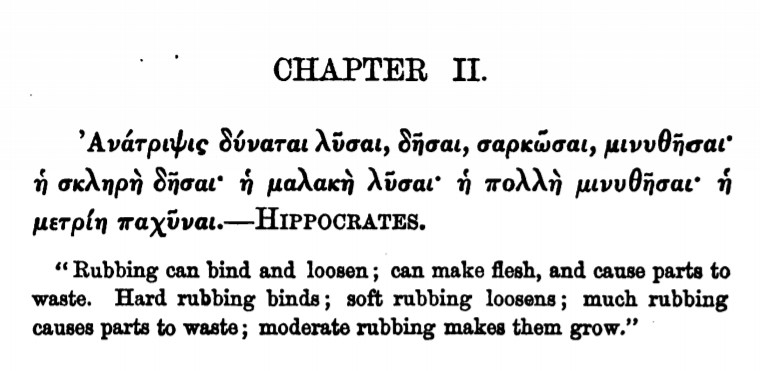
A History of the Art Termed Anatripsis by Hippocrates, Tripsis by Galen, Frictio by Celsus, Manipulation by Beveridge, and Medical Rubbing in Ordinary Language, from the Earliest Times to the Present Day. Followed by an Account of Its Virtues in the Cure of Disease and Maintenance of Health
By Walter Johnson · 1866
Hippocrates, in his work 'De Articulis,' writes, 'The physician, besides being accomplished in many other ways, must also understand massage.
Physician must be experienced in many things , ” says Hippocrates, “ but assuredly also in rubbing ; for things that have the same name have not always the same effects. For rubbing can bind a joint that is too loose and loosen a joint that is too rigid. And again, “ rubbing can bind and loosen ; can make flesh and cause parts to waste. Hard rubbing binds ; soft rubbing loosens ; much rubbing causes parts to waste ; moderate rubbing makes them grow . ” This is the earliest definite information about massage, and its truth and meaning are fully realized when the necessary previous conditions exist. Hippocrates was wiser than he was aware of, as we learn from the word that he used to designate the process of rubbing, namely, anatripsis, literally the process of rubbing up, and not down. In those days the circulation of the blood was not understood , the ancients supposing the arteries to be filled with air, and hence their name, which still clings to them.
A Practical Treatise on Massage Its History, Mode of Application, and Effects, Indications and Contra-indications; with Results in Over Fourteen Hundred Cases By Douglas Graham · 1884
Douglas Graham on Hippocrates.
The observations of Hippocrates must have been very accurate to discern that rubbing upwards in the case of the limbs had a more favorable effect than rubbing downwards, and doubtless in this manner he had experience in promoting the resorption of effusions ; for it is now well known that upward friction on the limbs favors the return of the circulation, relieves blood stasis , and makes more room in the veins and lymphatics for the carrying away of morbid products.
Science following art with limping pace, ” which so frequently
happens in the practice of medicine.Hippocrates was often referred to as the Father of Medicine,” who, having raised the art from a system of superstitious rites practised wholly by the priests, to the dignity of a learned profession, was then accused by his jealous contemporaries of having made too free use of the writings of others, and of having burned the collection to conceal his plagiarisms.
A Practical Treatise on Massage Its History, Mode of Application, and Effects, Indications and Contra-indications; with Results in Over Fourteen Hundred CasesBy Douglas Graham · 1884
“From the time of Hippocrates to that of Galen medical rubbing (not only before and after gymnastic exercises and before and after the bath, but also at different times of the day and for different diseases) was brought to so great a degree of perfection, that there were many theories advanced upon the subject, and various kinds of rubbing were distinguished.” General orthopædics, gymnastics and massage . by Busch, F. (Friedrich), 1844-1914; Ziemssen, H. von (Hugo), 1829-1902; Winternitz, W; Smith, E. Noble, (Eldred Noble), 1847-1906; Elsner, F. W. Google Books
Hippocrates, in his work ‘De Articulis,’ writes, ‘The physician, besides being accomplished in many other ways, must also understand massage.’ Massage may be used for strengthening a loose joint and also for loosening a stiff one. We shall, however, describe the details of this process farther on. These further details are partly to be found in the part ‘ De Officina Medici,’ which the work contains : ‘ Frictio si vehemens sit, dui’ari corpus ; si lenis, molliri ; si multa, minui; si modica, impleri ;’ and this pamphlet forms the foundation for all later treatises of antiquity dealing with rubbing.
General orthopædics, gymnastics and massage [electronic resource] by Busch, F. (Friedrich), 1844-1914; Ziemssen, H. von (Hugo), 1829-1902; Winternitz, W; Smith, E. Noble, (Eldred Noble), 1847-1906; Elsner, F. W.
Socrates
(c. 469-399)Greek philosopher
According to The Anatriptic Art A History of the Art Termed Anatripsis by Hippocrates, Tripsis by Galen, Frictio by Celsus, Manipulation by Beveridge, and Medical Rubbing in Ordinary Language, from the Earliest Times to the Present Day. Followed by an Account of Its Virtues in the Cure of Disease and Maintenance of HealthBy Walter Johnson · 1866
Referred to ” olive oil, the assuager of pain .” Now here, therefore, Plato, by the mouth of Socrates, reckons oil as only less necessary to human life than wheat and barley – not speaking of oil as an article of diet, but as applied externally ; because he terms it tóvwv åpwyniv , “ assuager of pain .” And oil used in the way of friction does allay pain in a remarkable manner; but taken internally it has no such effect. The statements of Plato are valuable not merely because they express the opinion of a deep thinker, not merely because they display to us one important element of the great Hellenic system of personal hygiene, but also because they reflect the doctrines of the medical school of Cos, which in those days had already reached the summit of its glory, and was without a rival in the world .
Plato
(c. 427-347)Greek philosopher
According to The Anatriptic Art A History of the Art Termed Anatripsis by Hippocrates, Tripsis by Galen, Frictio by Celsus, Manipulation by Beveridge, and Medical Rubbing in Ordinary Language, from the Earliest Times to the Present Day. Followed by an Account of Its Virtues in the Cure of Disease and Maintenance of HealthBy Walter Johnson · 1866
The writings of Plato abound with references, direct and indirect, to friction . A very remarkable passage occurs in the Menexenus. (A socratic dialogue of Plato)
Aristotle
(384-322)Greek philosopher
Aristotle was born on the Chalcidic peninsula of Macedonia, in northern Greece. His father, Nicomachus, was the physician of Amyntas III (reigned c. 393–c. 370 BCE), king of Macedonia and grandfather of Alexander the Great (reigned 336–323 BCE). After his father’s death in 367, Aristotle migrated to Athens, where he joined the Academy of Plato (c. 428–c. 348 BCE). He remained there for 20 years as Plato’s pupil and colleague.
Hippocrates
born c. 460 bce, island of Cos, Greece—died c. 375 bce, Larissa, Thessaly
431 BC – According to The Anatriptic Art A History of the Art Termed Anatripsis by Hippocrates, Tripsis by Galen, Frictio by Celsus, Manipulation by Beveridge, and Medical Rubbing in Ordinary Language, from the Earliest Times to the Present Day. Followed by an Account of Its Virtues in the Cure of Disease and Maintenance of Health By Walter Johnson · 1866
Hippocrates, who flourished in the time of the Peloponnesian war (which broke out B .C. 431), frequently mentions friction as a recognised and familiar remedy ; and in one pregnant aphorism he fully and tersely defines its effects. Here and there again he takes occasion to recommend friction in terms which prove his practical acquaintance with its uses; as in the following passage, speaking of the treatment of dislocation of the shoulder -joint after reduction, he says : — “ Those in whom the ligaments are attacked with inflammation cannot use the shoulder, for they are prevented by the pain and inflammatory tension. It is proper to treat such patients with cerate, and to bind the part with compresses and numerous bandages; to fill up the hollow of the armpit with a ball of soft cleansed wool, as a support for the bandage and a prop to the joint. To the arm there should be given for the most part an inclination upwards; for in this position the head of the shoulder will be most distinct from the spot into which it was dislocated . And when you have bandaged the shoulder, then it is proper to bind the arm to the side with a bandage passed round the body. And it is necessary to rub the shoulder gently and smoothly. The physician must be experienced in many things, but assuredly also in rubbing ; for things that have the same name have not the same effects. For rubbing can bind a joint which is too loose, and loosen a joint which is too hard . But 1 shall give a definition of rubbing in another discourse. However, a shoulder in the condition described should be rubbed with soft hands, and above all things gently ; but the joint should be moved about, not violently , but so far as it can be done without producing pain .” – HIPPOCRATES “ Peri Arthrõn ” Littré. Vol. iv., p . 100, et seq.
200 BC– The Huangdi Nei Jing (Yellow Emperor’s Inner Classic) is the earliest surviving canonical text of traditional Chinese medicine. Anmo is referred to in 30 different chapters of the Nei Jing.
According to The Anatriptic Art A History of the Art Termed Anatripsis by Hippocrates, Tripsis by Galen, Frictio by Celsus, Manipulation by Beveridge, and Medical Rubbing in Ordinary Language, from the Earliest Times to the Present Day. Followed by an Account of Its Virtues in the Cure of Disease and Maintenance of Health By Walter Johnson · 1866
Aulus Cornelius Celsus (c. 25 BC – c. 50 AD) was a Roman encyclopaedist, known for his extant medical work, De Medicina, which is believed to be the only surviving section of a much larger encyclopedia.
A . Cornelius Celsus, a very learned author, who wrote in the reign of Augustus or Tiberius, devotes a chapter of his work on Medicine to the consideration of the effects and uses of friction
100-44 BC– Romans. Julius Caesar used Massage therapy to relieve his neuralgia and epileptic seizures. Was thought to have been “Pinched” every day.
“ASCLEPIADES, 128-56 B. C., USED MASSAGE in conjunction with active and passive movements. Cicero and Julius Caesar were also advocates, the latter even allowing himself to be pinched daily as a treatment for neuralgia. Celsus believed most firmly in rubbing, advocating it for chronic pains of the head and for strengthening a paralyzed part. He mentions general treatment and also speaks of localization, but adds that sometimes treatment is necessary in a part other than the seat of pain which is along the same line of thought as vibratory treatment applied to “referred pain.” He also mentioned the length of treatment, saying that a general treatment if weakness be present should be shorter and gentler than a local treatment – an important consideration in vibratory treatment.” ~Mechanical Vibration, Its Physiological Application in Therapeutics By Mary Lydia Hastings Arnold Snow · 1912 Google Books
Douglas Graham on Asclepiades.
Asclepiades renounced almost entirely the use of medicine and attempted to restore free movement of the nutritive fluids and atoms by means of rubbing; one use of which amongst others he particularly recognized was that gentle stroking had a soporific influence. With this he also combined active and passive motion.
A Practical Treatise on Massage Its History, Mode of Application, and Effects, Indications and Contra-indications; with Results in Over Fourteen Hundred Cases By Douglas Graham · 1884
“Asclepiades almost completely gave up the use of medicine, and endeavoured in its place to restore free movement of the atoms by means of friction, the use of which led, amongst other things, to the knowledge of the narcotic effect produced by gentle strokings with the fingers. Frequent active and passive movements and baths, especially cold, were employed for the same purpose. Frictio, aqua, cjestatio were his chief remedies. Celsus devotes much care to describing the ‘ communia remedia,” which reached tlieir greatest development under Asclepiades. They were the ‘ frictio,’ ‘ unctio,’ «gestatio,’ ‘ abstinentia,’ and sudorifics, also sick diet.”
General orthopædics, gymnastics and massage [electronic resource] by Busch, F. (Friedrich), 1844-1914; Ziemssen, H. von (Hugo), 1829-1902; Winternitz, W; Smith, E. Noble, (Eldred Noble), 1847-1906; Elsner, F. W.
See also:
| Time Line History of Massage Timeline history of massage therapy 3000BC – 100BC Timeline history 100-1899 Timeline history – 1900-1950 Timeline history – 1950-2000 Timeline history 2000-2010 Timeline History 2010-2020 | History of Massage Through Google Books Early History of Massage through Google Books 1866-1921 History of Sports Massage History of Massage licensing by state The Phenomenal Growth of the Number of Massage Schools |
| History of AMTA History of AMTA by Ruth Williams History of AMTA- WA – includes PDFs of AMTA journals 1954-1960 History of AMTA National The Future of the Massage Profession -Franchises/schools | History of massage in Healthcare The history of Hospital Based Massage Therapy History of how WA State is able to bill health insurance – on my other site – www.massagepracticebuilder.com |
This page has been updated and revised many times. Many people have copied older versions of it and put it on your website. You can see clearly from the Internet Archives the Original Post in 2001 – See the History of Massage in the Archives.
It is copyrighted material. Even though the history of massage is general information, this timeline is proprietary information created by Julie Onofrio, Owner and author of this websites. It has taken me months and years to collect this information.
